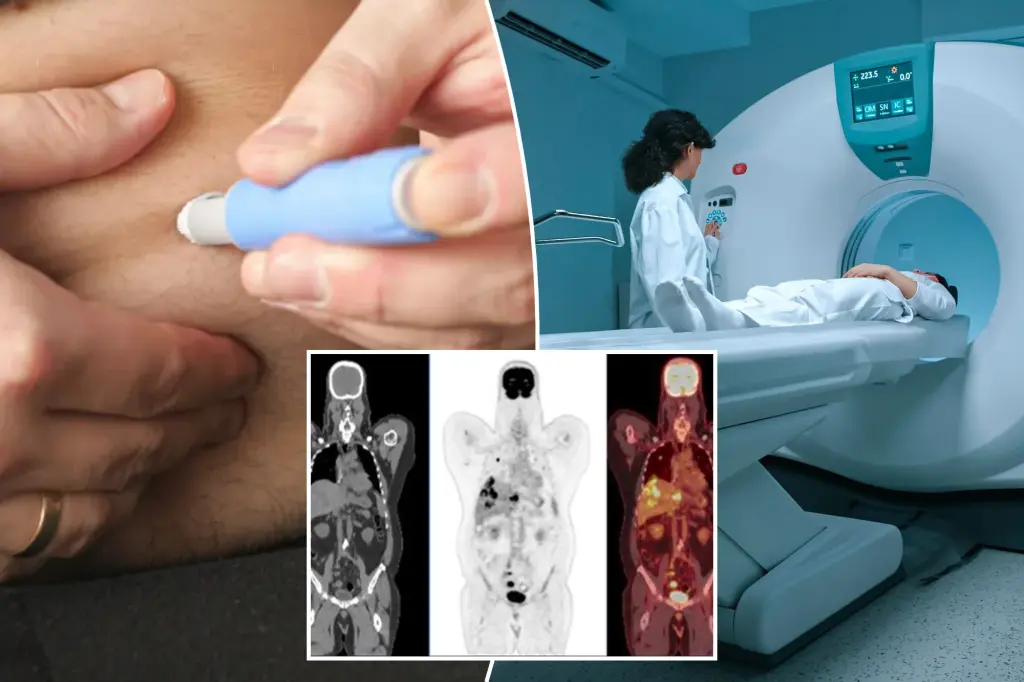THE UNEXPECTED IMPACT OF GLP-1 WEIGHT-LOSS DRUGS ON MEDICAL IMAGING
The meteoric rise of GLP-1 medications has revolutionized weight loss, offering hope to millions struggling with obesity and Type 2 diabetes. Originally developed as diabetes treatments, drugs like Ozempic, Wegovy, and Mounjaro have seen their usage skyrocket by an astonishing 700% between 2019 and 2023 in the United States alone. About one in eight American adults now report having used these medications, drawn by their remarkable ability to suppress appetite, slow digestion, and create a lasting feeling of fullness. While the physical transformations—from dramatic weight loss to unexpected side effects like sagging jowls and deflated breasts—have captured public attention, a more concerning issue is emerging in medical circles that could affect cancer detection and treatment.
New research presented at the 38th Annual Congress of the European Association of Nuclear Medicine reveals that GLP-1 medications may be interfering with crucial PET-CT scans—sophisticated imaging tools that doctors rely on to detect and monitor cancer and inflammatory diseases. The problem centers on how these drugs alter the body’s metabolic activity, creating unusual patterns when patients undergo these scans. Dr. Peter Strouhal, medical director at Alliance Medical Ltd in the UK and lead researcher on the study, noticed these anomalies first in individual patients, which prompted a wider investigation. “We found that these altered patterns are increasingly common,” he explained, “yet there is currently no national or international guidance in the UK addressing this emerging issue.”
The science behind this concern is rooted in how PET-CT scans work. These powerful diagnostic tools combine two different imaging technologies to give doctors a comprehensive view of what’s happening inside the body. The PET (Positron Emission Tomography) component involves injecting patients with a radioactive substance called FDG that travels through the bloodstream. Cancer cells and inflammatory tissues, which typically have higher metabolic rates, absorb more of this substance than normal cells. The scanner then detects the radiation emitted by the FDG, creating images that highlight these “hot spots” of activity. Meanwhile, the CT (Computed Tomography) scan provides detailed anatomical images of organs, bones, and tissues. Together, they create a metabolic-anatomical map that helps doctors identify abnormalities, make diagnoses, and track treatment responses.
However, patients taking GLP-1 medications are showing altered FDG uptake patterns during these scans. The drugs’ influence on metabolism creates unexpected hot spots that can either mask actual cancer signals or make healthy tissue appear diseased. This interference has serious implications for patient care. Misinterpreting these altered patterns could lead to unnecessary anxiety, additional testing, incorrect cancer staging, or—most concerning of all—dangerous delays in identifying and treating actual cancers. This problem is particularly alarming given that cancer rates in the United States are rising, especially among young adults, and early detection remains crucial for successful treatment outcomes. As more people turn to GLP-1 medications for weight management, the potential for scan misinterpretations grows, creating a healthcare challenge that spans both diagnosing new cancers and monitoring patients already undergoing treatment.
Despite these concerns, researchers aren’t currently recommending that patients discontinue their GLP-1 medications before undergoing PET-CT scans. Instead, Dr. Strouhal and his team emphasize the importance of thorough documentation of patients’ medication histories before imaging. This information can help radiologists and oncologists correctly interpret scan results while formal guidelines are being developed. “Recognizing the characteristic uptake associated with GLP-1 agonists helps avoid unnecessary anxiety and interventions,” Strouhal noted, “ensuring patients receive the right care, at the right time, without detours or doubt.” This approach acknowledges both the value these medications provide to patients and the need for accurate diagnostic information, striking a balance between continuing beneficial treatment and ensuring medical imaging remains reliable.
Looking ahead, the research team plans to expand their data collection across more imaging centers to strengthen the evidence base for future guidelines. They’re also aiming to collaborate internationally to develop consistent standards for interpreting PET-CT scans in patients taking GLP-1 medications. This global approach recognizes that as these drugs continue their worldwide popularity surge, the potential imaging interference is a universal medical challenge requiring coordinated solutions. For the millions of people benefiting from these medications—whether for diabetes management, weight loss, or both—this research represents an important step toward ensuring their other healthcare needs, particularly cancer screening and treatment, aren’t compromised by their GLP-1 use. As with many medical advances, the full picture of benefits, side effects, and interactions continues to evolve, underscoring the importance of ongoing research and communication between patients and their healthcare providers about all medications they’re taking before undergoing diagnostic procedures.


